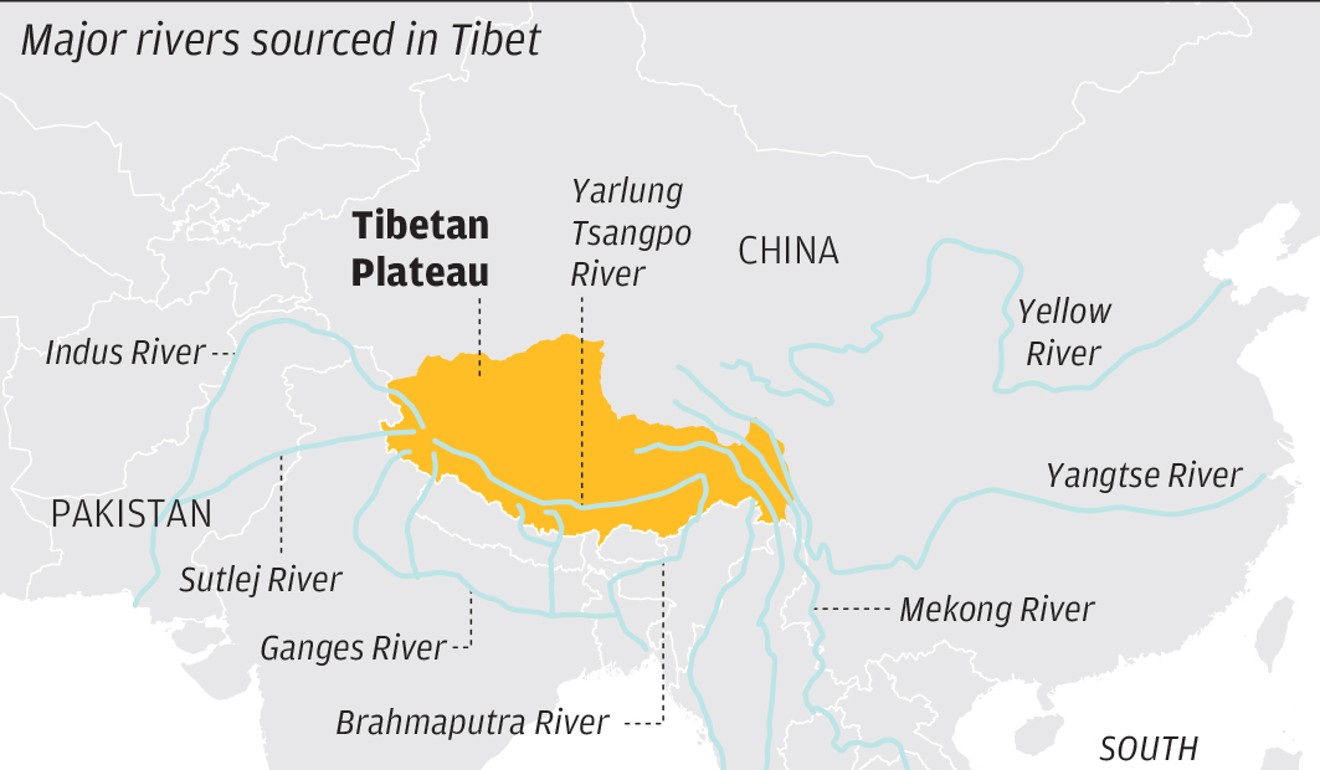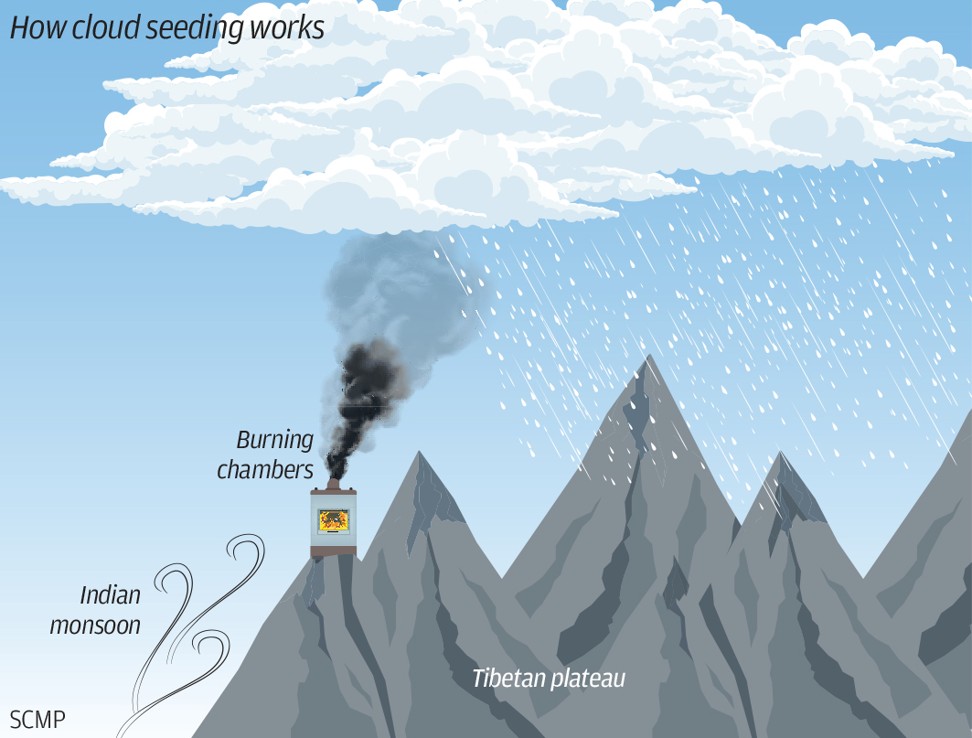What could Shirley go wrong?China needs more water. So it's building a rain-making network three times the size of Spain
China is testing cutting-edge defence technology to develop a powerful yet relatively low-cost weather modification system to bring substantially more rain to the Tibetan plateau, Asia’s biggest freshwater reserve. The system, which involves an enormous network of fuel-burning chambers installed high up on the Tibetan mountains, could increase rainfall in the region by up to 10 billion cubic metres a year – about 7 per cent of China’s total water consumption – according to researchers involved in the project.
Tens of thousands of chambers will be built at selected locations across the Tibetan plateau to produce rainfall over a total area of about 1.6 million square kilometres (620,000 square miles), or three times the size of Spain. It will be the world’s biggest such project. The chambers burn solid fuel to produce silver iodide, a cloud-seeding agent with a crystalline structure much like ice.
The chambers stand on steep mountain ridges facing the moist monsoon from south Asia. As wind hits the mountain, it produces an upward draft and sweeps the particles into the clouds to induce rain and snow. “[So far,] more than 500 burners have been deployed on alpine slopes in Tibet, Xinjiang and other areas for experimental use. The data we have collected show very promising results,” a researcher working on the system told the South China Morning Post.
The system is being developed by the state-owned China Aerospace Science and Technology Corporation – a major space and defence contractor that is also leading other ambitious national projects, including lunar exploration and the construction of China’s space station. Space scientists designed and constructed the chambers using cutting-edge military rocket engine technology, enabling them to safely and efficiently burn the high-density solid fuel in the oxygen-scarce environment at an altitude of over 5,000 metres (16,400 feet), according to the researcher who declined to be named due to the project’s sensitivity.
While the idea is not new – other countries like the United States have conducted similar tests on small sites – China is the first to attempt such a large-scale application of the technology. The chambers’ daily operation will be guided by highly precise real-time data collected from a network of 30 small weather satellites monitoring monsoon activities over the Indian Ocean.
The ground-based network will also employ other cloud-seeding methods using planes, drones and artillery to maximise the effect of the weather modification system. The gigantic glaciers and enormous underground reservoirs found on the Tibetan plateau, which is often referred to as Asia’s water tower, render it the source of most of the continent’s biggest rivers – including the Yellow, Yangtze, Mekong, Salween and Brahmaputra. The rivers, which flow through China, India, Nepal, Laos, Myanmar and several other countries, are a lifeline to almost half of the world’s population.
But because of shortages across the continent, the Tibetan plateau is also seen as a potential flashpoint as Asian nations struggle to secure control over freshwater resources. Despite the large volume of water-rich air currents that pass over the plateau each day, the plateau is one of the driest places on Earth. Most areas receive less than 10cm of rain a year. An area that sees less than 25cm of rain annually is defined as a desert by the US Geological Survey. Rain is formed when moist air cools and collides with particles floating in the atmosphere, creating heavy water droplets. The silver iodide produced by the burning chambers will provide the particles required to form rain.
Radar data showed that a gentle breeze could carry the cloud-seeding particles more than 1,000 metres above the mountain peaks, according to the researcher. A single chamber can form a strip of thick clouds stretching across more than 5km. “Sometimes snow would start falling almost immediately after we ignited the chamber. It was like standing on the stage of a magic show,” he said. The technology was initially developed as part of the Chinese military’s weather modification programme.
China and other countries, including Russia and the United States, have been researching ways to trigger natural disasters such as floods, droughts and tornadoes to weaken their enemies in the event of severe conflict. Efforts to employ the defence technology for civilian use began over a decade ago, the researcher said.
One of the biggest challenges the rainmakers faced was finding a way to keep the chambers operating in one of the world’s most remote and hostile environments. “In our early trials, the flame often extinguished midway [because of the lack of oxygen in the area],” the researcher said. But now, after several improvements to the design, the chambers should be able to operate in a near-vacuum for months, or even years, without requiring maintenance.
They also burn fuel as cleanly and efficiently as rocket engines, releasing only vapours and carbon dioxide, which makes them suitable for use even in environmentally protected areas. Communications and other electronic equipment is powered by solar energy and the chambers can be operated by a smart phone app thousands of kilometres away for through the satellite forecasting system.The chambers have one clear advantage over other cloud-seeding methods such as using planes, cannons and drones to blast silver iodide into the atmosphere.
“Other methods requires the establishment of a no-fly zone. This can be time-consuming and troublesome in any country, especially China,” the researcher said. The ground-based network also comes at a relatively low price – each burning unit costs about 50,000 yuan (US$8,000) to build and install. Costs are likely to drop further due to mass production.
In comparison, a cloud-seeding plane costs several million yuan and covers a smaller area. One downside of the burning chambers, however, is that they will not work in the absence of wind or when the wind is blowing the wrong direction. This month, the China Aerospace Science and Technology Corporation signed an agreement with Tsinghua University and Qinghai province to set up a large-scale weather modification system on the Tibetan plateau. In 2016 researchers from Tsinghua, China’s leading research university, first proposed a project – named Tianhe or Sky River – to increase the water supply in China’s arid northern regions by manipulating the climate.
The project aims to intercept the water vapour carried by the Indian monsoon over the Tibetan plateau and redistribute it in the northern regions to increase the water supply there by five to 10 billion cubic metres a year. The aerospace corporation’s president, Lei Fanpei, said in a speech that China’s space industry would integrate its weather modification programme with Tsinghua’s Sky River project.
“[Modifying the weather in Tibet] is a critical innovation to solve China’s water shortage problem,” Lei said. “It will make an important contribution not only to China’s development and world prosperity, but also the well being of the entire human race.” Tsinghua president Qiu Yong said the agreement signalled the central government’s determination to apply cutting-edge military technology in civilian sectors. The technology will significantly spur development in China’s western regions, he added.
The contents of the agreement are being kept confidential as it contains sensitive information that the authorities have deemed unsuitable to be revealed at the moment, a Tsinghua professor with knowledge of the deal told the Post. Climate simulations show that the Tibetan plateau is likely to experience a severe drought over the coming decades as natural rainfall fails to replenish the water lost as a result of rising temperatures.
“The satellite network and weather modification measures are to make preparations for the worst-case scenario,” the Tsinghua researcher said. The exact scale and launch date for the programme has not been fixed as it is pending final approval from the central government, he said.
Debate is also ongoing within the project team over the best approach for the project, he added. While some favour the use of the chambers, others prefer cloud-seeding planes as they have a smaller environmental footprint. Ma Weiqiang, a researcher with the Chinese Academy of Sciences’ Institute of Tibetan Plateau Research, said a cloud-seeding experiment on such a scale was unprecedented and could help answer many intriguing scientific questions.
In theory, the chambers could affect the weather and even the climate in the region if they are built in large enough numbers. But they might not work as perfectly in real life, according to the researcher. “I am sceptical about the amount of rainfall they can produce. A weather system can be huge. It can make all human efforts look vain,” Ma said. Beijing might not give the green light for the project either, he added, as intercepting the moisture in the skies over Tibet could have a knock-on effect and reduce rainfall in other Chinese regions.
http://www.scmp.com/news/china/society/ ... work-three
China Seeking to Cloud Seed the Tibetan Plateau
Forum rules
- This is a mountaineering forum, so please keep your posts on-topic. Posts do not all have to be related to the 14ers but should at least be mountaineering-related.
- Personal attacks and confrontational behavior will result in removal from the forum at the discretion of the administrators.
- Do not use this forum to advertise, sell photos or other products or promote a commercial website.
- Posts will be removed at the discretion of the site administrator or moderator(s), including: Troll posts, posts pushing political views or religious beliefs, and posts with the purpose of instigating conflict within the forum.
-
XterraRob

- Posts: 1179
- Joined: 7/20/2015
- 14ers: 42 7
- 13ers: 14
- Trip Reports (4)
China Seeking to Cloud Seed the Tibetan Plateau
RIP - M56
Re-introduce Grizzly Bears into the Colorado Wilderness™
Re-introduce Grizzly Bears into the Colorado Wilderness™
-
LURE

- Posts: 1303
- Joined: 6/27/2011
- 14ers: 35
- 13ers: 11
- Trip Reports (0)
Re: China Seeking to Cloud Seed the Tibetan Plateau
What do you mean what could go wrong?
We've been experimenting with this for a while in Colorado - http://cwcb.state.co.us/water-managemen ... ogram.aspx
Worst case scenario, you really don't change the moisture all that much.
We've been experimenting with this for a while in Colorado - http://cwcb.state.co.us/water-managemen ... ogram.aspx
Worst case scenario, you really don't change the moisture all that much.
Re: China Seeking to Cloud Seed the Tibetan Plateau
Because sure more CO2 is better than just reducing it.
A man has got to know his limitations.-Dr. Jonathan Hemlock or Harry Callahan or something F' it: http://youtu.be/lpzqQst-Sg8
'Life is too short to ski groomers'
"That man's only desire was to stand, once only, on the summit of that glorious wedge of rock...I think anyone who loves the mountains as much as that can claim to be a mountaineer, too."-Hermann Buhl, Nanga Parbat Pilgrimage
'Life is too short to ski groomers'
"That man's only desire was to stand, once only, on the summit of that glorious wedge of rock...I think anyone who loves the mountains as much as that can claim to be a mountaineer, too."-Hermann Buhl, Nanga Parbat Pilgrimage
-
WVMountaineer

- Posts: 239
- Joined: 6/23/2017
- 14ers: 58 4
- Trip Reports (0)
Re: China Seeking to Cloud Seed the Tibetan Plateau
If this is real and if it works that could be a game changer... Same goes to say if it doesn't work and has severe consequences. I wonder what the CO2 emission would be compared to a car burning gas 24 hrs a day. As an engineer, I want to believe in efforts like this.XterraRob wrote:What could Shirley go wrong?
Edited:
A quick Google search for sanity turned up this -> https://denverwatertap.org/2018/02/12/d ... ding-help/
“The dry winters are when everyone hopes cloud seeding can help with the snow, but unfortunately that’s not how it works,”
Guess we will see...
Last edited by WVMountaineer on Mon Mar 26, 2018 4:51 pm, edited 2 times in total.
"There are two ways to measure life; the number of days you simply exist or the number of days you spend truly living your human experience." 14ers.com user goingup
-
719BR

- Posts: 488
- Joined: 7/19/2016
- 13ers: 8
- Trip Reports (0)
Re: China Seeking to Cloud Seed the Tibetan Plateau
Is that you Al Gore?jmanner wrote:Because sure more CO2 is better than just reducing it.
-
XterraRob

- Posts: 1179
- Joined: 7/20/2015
- 14ers: 42 7
- 13ers: 14
- Trip Reports (4)
Re: China Seeking to Cloud Seed the Tibetan Plateau
The scale of the project and of course, Murphy's Law.LURE wrote:What do you mean what could go wrong?
We've been experimenting with this for a while in Colorado - http://cwcb.state.co.us/water-managemen ... ogram.aspx
Worst case scenario, you really don't change the moisture all that much.
RIP - M56
Re-introduce Grizzly Bears into the Colorado Wilderness™
Re-introduce Grizzly Bears into the Colorado Wilderness™
-
Scott P

- Posts: 9598
- Joined: 5/4/2005
- 14ers: 58 16
- 13ers: 50 13
- Trip Reports (16)
Re: China Seeking to Cloud Seed the Tibetan Plateau
The thing about cloud seeding is that it creates a rain shadow effect. Areas downwind receive less precipitation after cloud seeding.
I'm old, slow and fat. Unfortunately, those are my good qualities.
-
LURE

- Posts: 1303
- Joined: 6/27/2011
- 14ers: 35
- 13ers: 11
- Trip Reports (0)
Re: China Seeking to Cloud Seed the Tibetan Plateau
Yeah from the little bits I’ve read it doesn’t do much. I think the studies show that it can and does actually work, but not in any way that actually has any significant impact to surface water supplies.WVMountaineer wrote:If this is real and if it works that could be a game changer... Same goes to say if it doesn't work and has severe consequences. I wonder what the CO2 emission would be compared to a car burning gas 24 hrs a day. As an engineer, I want to believe in efforts like this.XterraRob wrote:What could Shirley go wrong?
Edited:
A quick Google search for sanity turned up this -> https://denverwatertap.org/2018/02/12/d ... ding-help/
“The dry winters are when everyone hopes cloud seeding can help with the snow, but unfortunately that’s not how it works,”
Guess we will see...
-
peter303
- Posts: 3570
- Joined: 6/17/2009
- 14ers: 34
- 13ers: 12
- Trip Reports (3)
Re: China Seeking to Cloud Seed the Tibetan Plateau
Rest assure, if central Colorado ever has three drought years in a row, we will be hearing such schemes for the Rockies. I have been here when there have been two drought years in a row. People start getting anxious then. The paleoclimate record hints there have been droughts in the US southwest lasting up to 60 years, perhaps depoluating Mesa Verde and Chaco Canyon.
Re: China Seeking to Cloud Seed the Tibetan Plateau
As Lure has pointed out, there isn't much evidence they do enough. If nothing else cause and effect still matters in weather. If you pull water out of the sky here(or in Tibet) it wont be there down the line; wherever that is.peter303 wrote:Rest assure, if central Colorado ever has three drought years in a row, we will be hearing such schemes for the Rockies. I have been here when there have been two drought years in a row. People start getting anxious then. The paleoclimate record hints there have been droughts in the US southwest lasting up to 60 years, perhaps depoluating Mesa Verde and Chaco Canyon.
A man has got to know his limitations.-Dr. Jonathan Hemlock or Harry Callahan or something F' it: http://youtu.be/lpzqQst-Sg8
'Life is too short to ski groomers'
"That man's only desire was to stand, once only, on the summit of that glorious wedge of rock...I think anyone who loves the mountains as much as that can claim to be a mountaineer, too."-Hermann Buhl, Nanga Parbat Pilgrimage
'Life is too short to ski groomers'
"That man's only desire was to stand, once only, on the summit of that glorious wedge of rock...I think anyone who loves the mountains as much as that can claim to be a mountaineer, too."-Hermann Buhl, Nanga Parbat Pilgrimage
-
Sean Nunn
- Posts: 857
- Joined: 7/29/2013
- 14ers: 35
- 13ers: 2
- Trip Reports (0)
Re: China Seeking to Cloud Seed the Tibetan Plateau
Say it ain't so. I thought that all hurricanes, tornadoes, floods, and droughts were caused by global warming, errr, climate change.peter303 wrote: The paleoclimate record hints there have been droughts in the US southwest lasting up to 60 years, perhaps depoluating Mesa Verde and Chaco Canyon.
"Thy righteousness is like the great mountains."
Psalm 36:6
Psalm 36:6
Re: China Seeking to Cloud Seed the Tibetan Plateau
The world is always perfect exactly the way it is.




